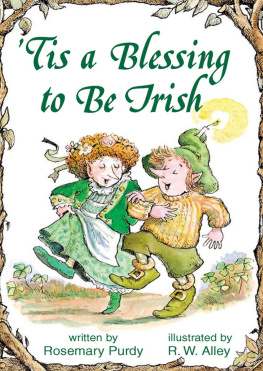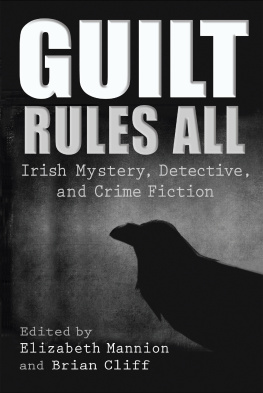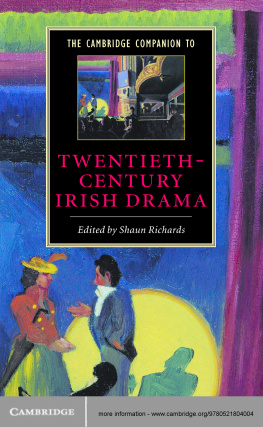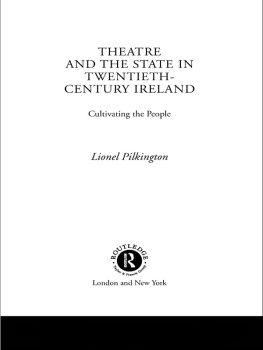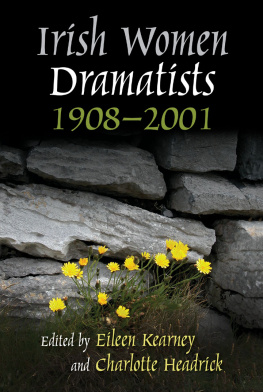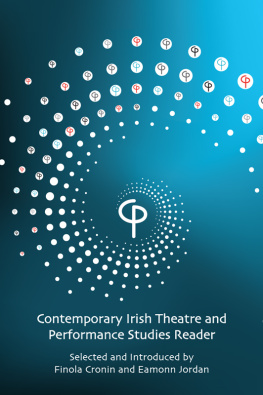Sacred Play
Soul-journeys
in Contemporary Irish Theatre
Sacred Play
Soul-journeys
in Contemporary Irish Theatre
Anne F. OReilly
Carysfort Press
A Carysfort Press Book
Sacred Play: Soul-journeys in Contemporary Irish Theatre
Anne F. OReilly
First published in Ireland in 2004 as a paperback original by Carysfort Press, 58 Woodfield, Scholarstown Road, Dublin 16, Ireland
2004 Copyright remains with the author
Typeset by Carysfort Press
Cover design by Alan Bennis
Printed and bound by eprint Limited
35 Coolmine Industrial Estate, Blanchardstown,
Dublin 15, Ireland
Published with the support of the Research Committee, St. Patricks College, Drumcondra, and by a grant from the the Arts Council.
Caution: All rights reserved. No part of this book may be printed or reproduced or utilized in any form or by any electronic, mechanical, or other means, now known or hereafter invented including photocopying and recording, or in any information storage or retrieval system without permission in writing from the publishers.
This paperback is sold subject to the conditions that it shall not by way of trade or otherwise, be lent, resold, hired out, or otherwise circulated in any form of binding, or cover other than that in which it is published and without a similar condition, including this condition, being imposed on the subsequent purchaser.
To my soul mate, Deirdre
and to my children Sinad and Brian
who have taught me how to play again.
Acknowledgements
This book has grown out of my teaching and research over the past thirty years. My interpretive framework has developed from a dialogue with theology, feminist theory and the Irish dramatic tradition. A number of Irish academic environments have nurtured and sustained my own intellectual journey: The Religious Studies faculty at the Mater Dei Institute Dublin; the Theology faculty of St. Patricks College Maynooth; the Drama Studies faculty of University College Dublin and the Department of English at NUI Galway. I am grateful to all my teachers from these different disciplines, in particular Dr. Eamonn Jordan, who supervised my studies and who saw the possibility of this book long before I did.
I acknowledge the support of friends and colleagues who have read parts of the book in earlier formats. Many conversations have facilitated the development and clarification of my ideas. Gratitude must also go to the Religious Studies Department at St. Patricks College, Drumcondra, Dublin, who have always supported and enabled my continuing studies.
Behind the book is another journey that has brought me into dialogue with Western and Eastern mysticism, psychotherapy, and many contemporary innovative approaches to the relationship between body and spirit. The work of Dr. Ruth Doherty, (Annwn Institute) and Chloe Goodchild (The Naked Voice) deserve special mention. My ongoing soul-journey work with Kevin Harnett has been an invaluable source of insight and wisdom.
I am very grateful to all my students both past and present, with whom I have shared many of the ideas in this book. I thank my students in St. Marys Holy Faith Secondary School (Glasnevin, Dublin), the women from the Creative Writing classes at The Shanty Educational Project (West Tallaght, Dublin), the children and teenagers in Irelands Centre for Talented Youth (DCU Dublin), and most especially my Religious Studies students in St Patricks College, who provide me with ongoing opportunities for dialogue, reflection, creativity and play.
Finally, to close friends and family, who have tolerated my absence, tiredness, and preoccupation over the past few years thanks for your patience and practical support. You kept me grounded. Anne OReilly
The virtue of play is when we do not take ourselves, or our world, or our God, literally. When we learn the humility and humour of participating in a game without emperors. Like a child playing in the sand by the edge of the sea. Not idle play. Sacred play upon which the future of our world reposes.
Richard Kearney
Introduction | Sacred Play
At first there is nothing. Nothing but the empty space. The womb that begets all life the space of nothingness and possibility, emptiness and potential form. The trajectory of the human journey is from the source into life and back again to the source from nothingness to separateness and back to nothingness. It is also the trajectory of creativity, of each work of art, of each participation in the play of images.
In the empty space of theatre audiences are invited to participate not simply in the performance of a particular play, but in the play of creation itself. Audiences are invited to recognize that the possibility of anything at all underlies all our attempts to create, to make, shape and invent new worlds. If theatre is one of the sacred spaces wherein we can ritually recreate the world, it can only function as such because it is part of a greater creative energy that underpins and enables everything. Martin Boroson, founder of the Temenosdevelops his understanding of theatre from Hindu philosophy where creation is understood to have come about because of Gods desire to play (lila). As Boroson puts it:
In this view of creation, the universe is an enormous play that is conceived, written, directed, produced and designed by God. It is God in the audience, God working the lights, and God playing every role. The point of this play is to make something so convincingly tangible that it actually appears to be not-God. (66)
Borosons interest in theatre led to his search to find a way to make modern theatre a temenos a strong and sacred container in which people can experience the deepest kinds of play, the play of gods. Play can be fun, of course, but it can also be transcendent. Sometimes, it can be both. (66)
We may ask who in fact is playing? Behind and beneath all our playing may lie the play of the divine. Our lives may be premised on forgetting or the source may be obscured. The illusion of separation prevents the realization that underneath the many manifestations of forms we are all connected. We breathe the same breath. The mystics east and west always had access to this kind of unified experience of existence. Kilroys Matt Talbot tries to talk about such an experience:
There be nuthin to see when Gawd comes cause theres nuthin other than yerself cause yerself is wan with whah ya see so ya see nuthin cause ya can only see whats separate than yerself, ya can only count whats different, not the same, not the wan, the only. (Kilroy: 1997:58)
When he wrote of the empty space of theatre the renowned theatre director Peter Brook had in mind the theatre of the invisible made visible. Theatrical playing can open to moments of epiphany, where the source comes through, and transfigures the ordinary, making it holy. Theatre as sacred play invites a new imagining of the divine human relationship. The human impulse towards transformative play is itself a participation in the play of the divine.
The Clearing or the ritual space of theatre, also invites audiences to play, dance, sing and cry their way towards a new imagining. The theatrical space nurtures a passion for the possible and invites us to have faith in the imagination. In Toni Morrisons novel Beloved we encounter the matriarchal lay preacher Baby Suggs, who opened her great heart to those who could use it (1987:87). Regularly she would retire to the Clearing in the forest and lead her people in a healing ritual. She would invite the children, the men and their wives to laugh and dance and weep together before she would share her great embodied wisdom with them. She told them that the only grace they could have was the grace they could imagine. (1987:88) Theatre too can become a place of embodied wisdom.
Next page

